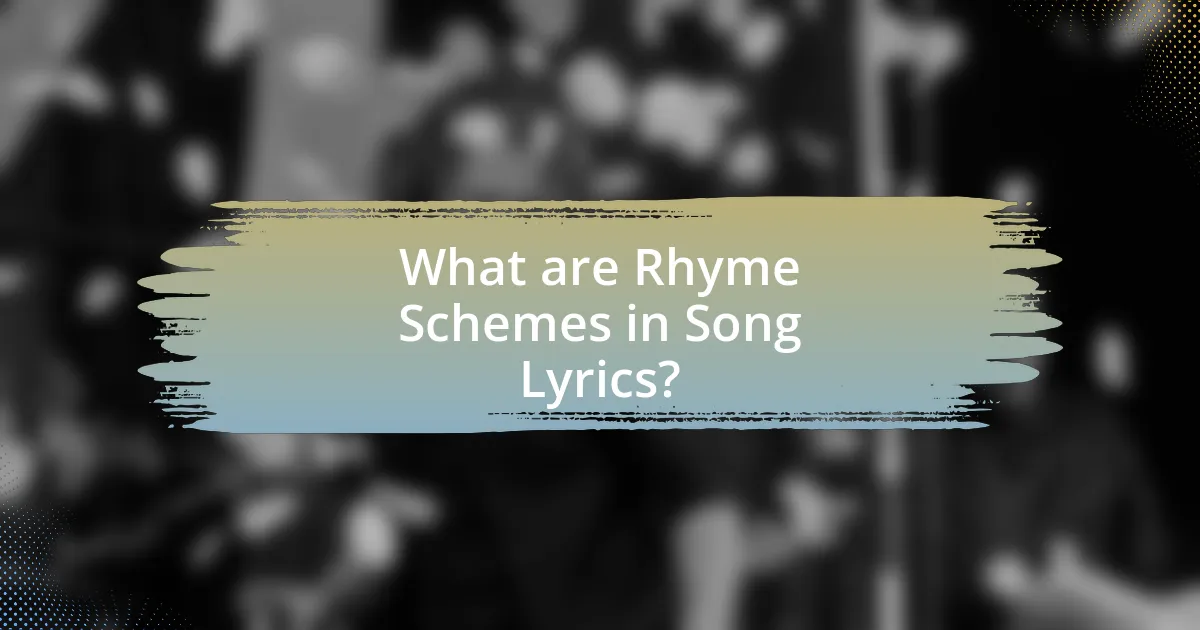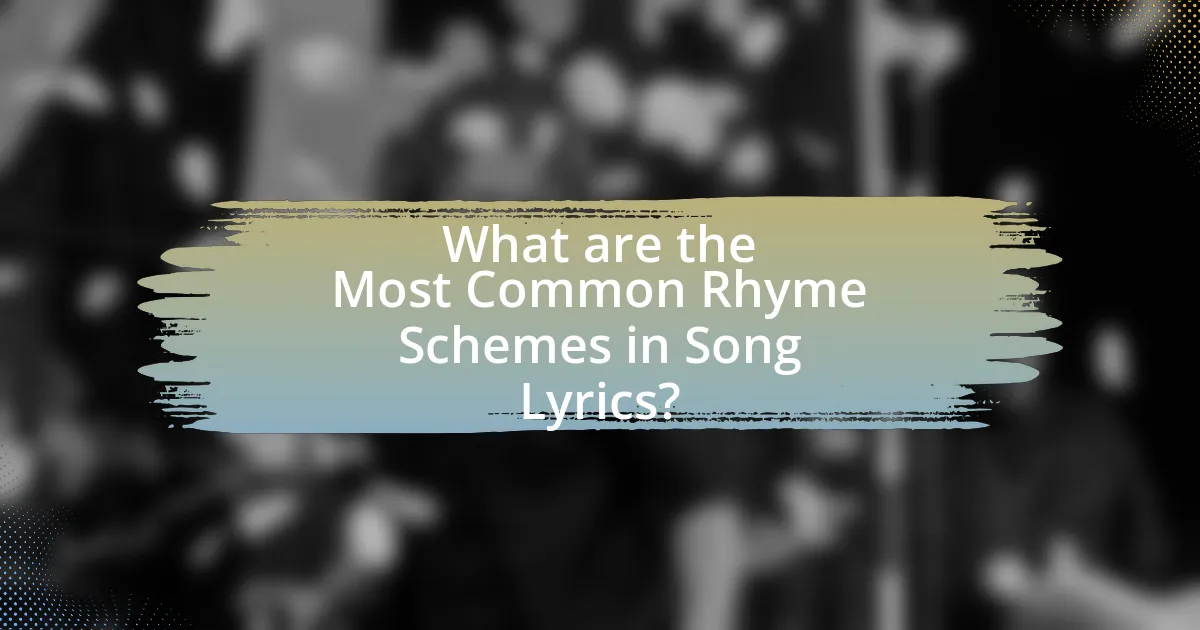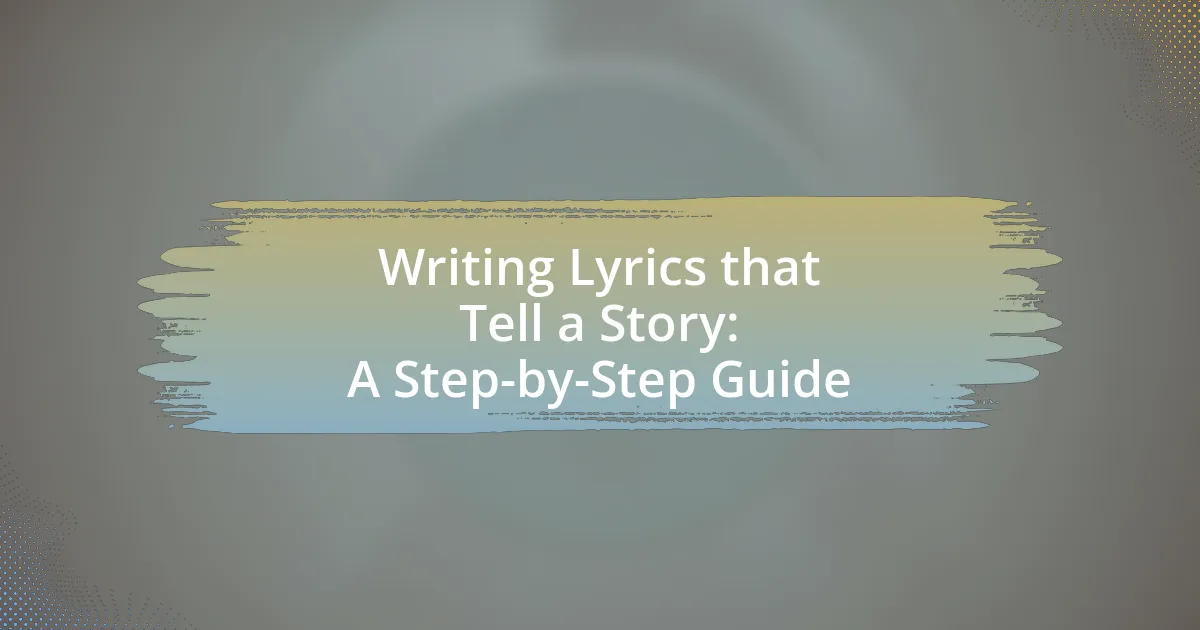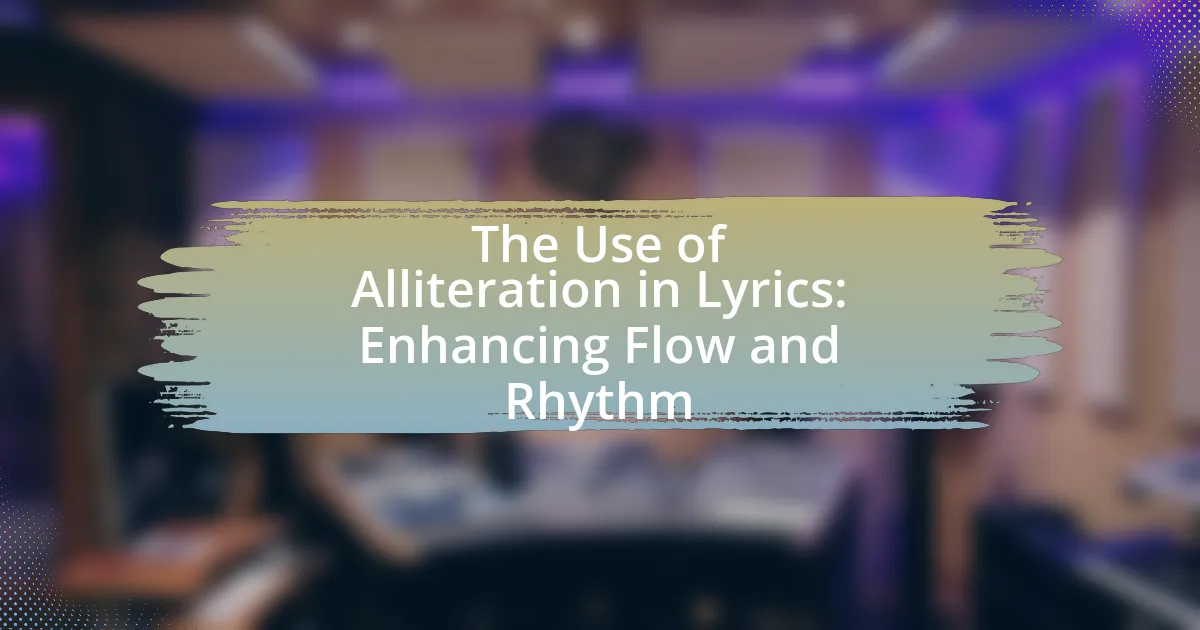The article focuses on exploring different rhyme schemes in song lyrics, detailing how these patterns enhance the musicality, memorability, and emotional impact of songs. It outlines common rhyme schemes such as AABB, ABAB, and ABCB, explaining their structural characteristics and significance in songwriting. Additionally, the article discusses the role of rhyme schemes in listener engagement, thematic development, and emotional resonance, while providing insights into techniques for songwriters to effectively utilize these patterns. It also highlights resources for learning about rhyme schemes and best practices for incorporating them into songwriting.

What are Rhyme Schemes in Song Lyrics?
Rhyme schemes in song lyrics refer to the pattern of rhymes at the end of each line within a verse or stanza. These patterns can enhance the musicality and memorability of a song, with common schemes including AABB, ABAB, and ABCB. For example, in an AABB rhyme scheme, the first two lines rhyme with each other, and the next two lines form a separate rhyming pair. This structured approach to rhyming is prevalent in various musical genres, contributing to the overall aesthetic and emotional impact of the lyrics.
How do rhyme schemes enhance the lyrical quality of songs?
Rhyme schemes enhance the lyrical quality of songs by creating a structured pattern that improves memorability and emotional resonance. This structure allows listeners to anticipate sounds, which can evoke feelings and enhance engagement with the song. For example, the ABAB rhyme scheme is commonly used in popular music, as it provides a rhythmic flow that complements melodies, making lyrics easier to remember. Studies in music psychology indicate that songs with consistent rhyme schemes are often perceived as more enjoyable and are more likely to be replayed, demonstrating the impact of rhyme on listener preference and retention.
What are the different types of rhyme schemes commonly used in songwriting?
The different types of rhyme schemes commonly used in songwriting include AABB, ABAB, ABCB, and ABBA. AABB features pairs of rhyming lines, while ABAB alternates rhymes between lines. ABCB has the second and fourth lines rhyming, and ABBA creates an enclosed rhyme pattern. These schemes are foundational in songwriting, as they help establish rhythm and enhance lyrical flow, making songs more memorable and engaging.
How do rhyme schemes contribute to the overall theme of a song?
Rhyme schemes significantly enhance the overall theme of a song by creating a structured pattern that reinforces the lyrical message. For instance, a consistent rhyme scheme can evoke a sense of harmony and unity, aligning with themes of love or nostalgia, while irregular schemes may reflect chaos or emotional turmoil, aligning with themes of struggle or conflict. Research indicates that songs with varied rhyme schemes can engage listeners more effectively, as they create memorable hooks and emotional resonance, thereby deepening the thematic impact. This relationship between rhyme and theme is evident in various musical genres, where artists intentionally choose rhyme patterns to complement their lyrical narratives.
Why are rhyme schemes important in music composition?
Rhyme schemes are important in music composition because they enhance the lyrical structure and emotional impact of a song. A well-defined rhyme scheme creates a sense of rhythm and flow, making lyrics more memorable and engaging for listeners. For example, songs that utilize consistent rhyme patterns, such as ABAB or AABB, often resonate better with audiences, as these patterns facilitate easier recall and sing-along potential. Studies in music theory indicate that songs with effective rhyme schemes can lead to higher listener retention and enjoyment, demonstrating their significance in crafting compelling musical narratives.
How do rhyme schemes affect listener engagement and memorability?
Rhyme schemes significantly enhance listener engagement and memorability by creating patterns that are easier to follow and recall. When lyrics employ consistent rhyme patterns, they establish a rhythmic structure that captures attention and aids in retention. Research indicates that songs with predictable rhyme schemes, such as ABAB or AABB, are more likely to be remembered by listeners, as these patterns facilitate cognitive processing and emotional connection. For instance, a study published in the Journal of Experimental Psychology found that participants could recall lyrics more effectively when they featured structured rhyme schemes compared to free verse. This demonstrates that rhyme schemes not only engage listeners but also improve their ability to remember the content.
What role do rhyme schemes play in the emotional impact of a song?
Rhyme schemes significantly enhance the emotional impact of a song by creating patterns that evoke feelings and reinforce themes. These patterns can establish a sense of familiarity and expectation, which can amplify the listener’s emotional response. For example, a consistent rhyme scheme can create a soothing effect, while irregular schemes may evoke tension or surprise, aligning with the song’s emotional narrative. Research indicates that songs with varied rhyme schemes can engage listeners more deeply, as demonstrated in studies analyzing listener reactions to different lyrical structures.

What are the Most Common Rhyme Schemes in Song Lyrics?
The most common rhyme schemes in song lyrics include AABB, ABAB, and ABCB. AABB features pairs of rhyming lines, creating a straightforward and catchy structure, often used in pop and children’s songs. ABAB alternates rhymes, providing a more complex and engaging flow, frequently found in rock and folk music. ABCB, which has the second and fourth lines rhyming, is popular in ballads and storytelling songs, allowing for narrative development while maintaining a lyrical quality. These rhyme schemes are prevalent due to their effectiveness in enhancing memorability and emotional resonance in music.
What is the structure of a couplet rhyme scheme?
A couplet rhyme scheme consists of two consecutive lines of verse that rhyme with each other, typically denoted as AA. In this structure, the end words of both lines share the same sound, creating a rhythmic and cohesive effect. This rhyme scheme is commonly used in poetry and song lyrics to enhance memorability and lyrical flow, as seen in works by poets like Alexander Pope and in various musical genres.
How does the couplet rhyme scheme influence song flow?
The couplet rhyme scheme significantly influences song flow by creating a rhythmic and predictable structure that enhances memorability. This scheme, characterized by pairs of lines that rhyme, establishes a sense of closure and completeness at the end of each couplet, which can propel the listener through the song. The predictability of the rhyme encourages engagement, as listeners anticipate the next rhyme, thereby maintaining their interest and emotional connection. Additionally, the couplet structure allows for concise storytelling or thematic development, as each couplet can encapsulate a distinct idea or emotion, facilitating a smooth transition between different sections of the song.
What are some famous songs that utilize couplet rhyme schemes?
Famous songs that utilize couplet rhyme schemes include “Twinkle, Twinkle, Little Star” and “Rapper’s Delight” by the Sugarhill Gang. In “Twinkle, Twinkle, Little Star,” each pair of lines ends with rhyming words, creating a simple and memorable structure. Similarly, “Rapper’s Delight” features multiple couplets throughout its verses, showcasing the effectiveness of this rhyme scheme in hip-hop. These examples illustrate how couplet rhyme schemes enhance lyrical flow and memorability in music.
How does the ABAB rhyme scheme work?
The ABAB rhyme scheme consists of alternating lines that rhyme, specifically where the first and third lines rhyme with each other, and the second and fourth lines rhyme with each other. In this structure, the pattern creates a rhythmic and cohesive flow, commonly used in poetry and song lyrics to enhance musicality and memorability. For example, in a quatrain, the first line (A) rhymes with the third line (A), while the second line (B) rhymes with the fourth line (B), forming a clear and recognizable pattern that aids in the overall aesthetic of the piece. This scheme is prevalent in various literary works, demonstrating its effectiveness in engaging audiences through its structured yet dynamic form.
What are the advantages of using an ABAB rhyme scheme in lyrics?
The advantages of using an ABAB rhyme scheme in lyrics include enhanced musicality and improved memorability. This rhyme scheme creates a rhythmic pattern that engages listeners, making the song more enjoyable and easier to remember. Additionally, the alternating rhyme can help to establish a narrative flow, allowing for a clear progression of ideas within the lyrics. Studies in music theory suggest that structured rhyme schemes, like ABAB, contribute to the overall appeal of a song, as they provide a familiar framework that listeners can easily follow.
Can you provide examples of songs that feature an ABAB rhyme scheme?
Examples of songs that feature an ABAB rhyme scheme include “Love Story” by Taylor Swift and “Firework” by Katy Perry. In “Love Story,” the alternating rhyme pattern enhances the narrative quality of the lyrics, while “Firework” uses the ABAB structure to create a memorable and uplifting message. Both songs demonstrate how the ABAB rhyme scheme can effectively contribute to the overall impact of the lyrics.

How Can Songwriters Effectively Use Rhyme Schemes?
Songwriters can effectively use rhyme schemes by selecting patterns that enhance the lyrical flow and emotional impact of their songs. Utilizing common schemes such as AABB, ABAB, or ABCB can create memorable hooks and improve listener engagement. For instance, the AABB scheme provides a straightforward and catchy rhythm, while ABAB introduces variation that can maintain interest throughout the verses. Research indicates that songs with structured rhyme schemes are often perceived as more appealing and easier to remember, which supports the idea that effective rhyme usage can significantly influence a song’s success.
What techniques can songwriters employ to create unique rhyme schemes?
Songwriters can employ techniques such as internal rhymes, slant rhymes, and varied syllable counts to create unique rhyme schemes. Internal rhymes occur within a single line, enhancing rhythm and complexity, while slant rhymes involve similar but not identical sounds, allowing for creative flexibility. Additionally, varying syllable counts can disrupt predictable patterns, leading to more innovative structures. These techniques are supported by examples in popular music, where artists like Eminem and Bob Dylan utilize them to enhance lyrical depth and engagement.
How can varying rhyme schemes enhance lyrical storytelling?
Varying rhyme schemes enhance lyrical storytelling by creating emotional dynamics and emphasizing key themes. Different rhyme patterns can evoke distinct feelings; for instance, an ABAB scheme may convey a sense of movement and progression, while an AABB scheme can create a more playful or intimate tone. This variation allows songwriters to manipulate the listener’s emotional response and maintain engagement throughout the narrative. Additionally, studies in music theory indicate that unexpected rhyme schemes can surprise listeners, making the lyrics more memorable and impactful, thereby reinforcing the story being told.
What are some common pitfalls to avoid when using rhyme schemes?
Common pitfalls to avoid when using rhyme schemes include forced rhymes, which can disrupt the flow of lyrics, and over-reliance on predictable patterns, leading to a lack of originality. Forced rhymes occur when a writer prioritizes rhyme over meaning, resulting in awkward phrasing. Over-reliance on predictable patterns can make lyrics sound clichéd and uninspired, as listeners may anticipate the rhyme before it occurs. Additionally, neglecting the emotional context of the lyrics can lead to disconnection between the rhyme scheme and the song’s message, diminishing its impact.
What resources are available for learning about rhyme schemes?
Resources available for learning about rhyme schemes include online platforms, textbooks, and educational websites. Websites like Poetry Foundation and Writers’ Digest provide comprehensive guides and examples of various rhyme schemes. Textbooks such as “The Poetry Home Repair Manual” by Ted Kooser offer structured insights into rhyme and meter. Additionally, online courses on platforms like Coursera and Udemy cover poetic forms, including rhyme schemes, providing interactive learning experiences. These resources collectively enhance understanding of rhyme schemes in poetry and song lyrics.
How can songwriters practice and refine their use of rhyme schemes?
Songwriters can practice and refine their use of rhyme schemes by analyzing existing songs, writing regularly, and experimenting with different patterns. Analyzing songs allows songwriters to identify effective rhyme schemes used by successful artists, which can inspire their own work. Regular writing helps develop fluency and comfort with various rhyme structures, while experimentation encourages creativity and innovation in lyric composition. For instance, a study by the University of Southern California found that consistent practice in writing can significantly enhance a songwriter’s ability to craft compelling lyrics, including the effective use of rhyme schemes.
What tools can assist in analyzing rhyme schemes in existing songs?
Tools that can assist in analyzing rhyme schemes in existing songs include RhymeZone, Genius, and various lyric analysis software. RhymeZone provides a comprehensive database of rhymes and can help identify patterns in lyrics. Genius allows users to annotate and analyze song lyrics, revealing rhyme schemes and structures through community contributions. Additionally, software like LyricFind and specialized music analysis tools can automate the identification of rhyme patterns, making it easier to study the lyrical composition of songs. These tools are widely used by songwriters, educators, and music analysts to enhance their understanding of lyrical techniques.
What are some best practices for incorporating rhyme schemes in songwriting?
Incorporating rhyme schemes in songwriting effectively involves using consistent patterns that enhance lyrical flow and memorability. Best practices include selecting a rhyme scheme that complements the song’s mood, such as AABB for a playful tone or ABAB for a more complex structure. Additionally, varying the rhyme types—such as using slant rhymes or internal rhymes—can add depth and interest to the lyrics.
Moreover, maintaining a balance between rhyme and meaning is crucial; lyrics should convey emotion and narrative while adhering to the chosen scheme. An example of this is found in classic songwriting, where artists like Bob Dylan often employed varied rhyme schemes to enrich storytelling without sacrificing lyrical integrity. This approach not only engages listeners but also reinforces the song’s themes and emotions.





